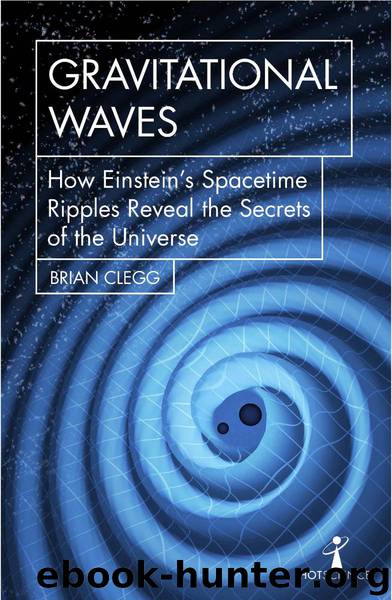Gravitational Waves by Brian Clegg

Author:Brian Clegg [Brian Clegg]
Language: eng
Format: epub
ISBN: 9781785783210
Publisher: Icon Books Ltd
Published: 2017-03-18T04:00:00+00:00
Simulating the universe
A lot of the experimentalists’ time was spent during the thirteen years between 2002 and 2015 on ensuring that the equipment was working properly, as it had been gradually upgraded to provide greater and greater sensitivity. But the theoreticians were not left twiddling their thumbs. One problem that gravitational wave astronomers face is that they can’t necessarily see using conventional astronomy the sources they observe through gravitational waves. (In fact, none of the successful detections so far has had any light-based evidence to back it up.) So, given a wave trace detected by both observatories, the scientists have to work out exactly what it is that they are seeing.
To an extent this has always been a problem with, for example, radio astronomy, which also involves detecting a wave-like signal in a data stream. But it is much easier to be certain of the direction a radio signal comes from, as most radio telescopes are highly directional, and radio sources are often also visible as light sources in different bands. By combining different frequencies of light from radio through the visible up to X-rays and gamma rays, it is often possible to get a clear picture of what is being observed. But a gravitational wave event may well consist of just a fraction of a second of a wave being detected and that’s all the physicists have to work on. No backup. No obvious mechanism for interpretation.
As far back as the 1960s it was realised that the only realistic way to deal with some gravitational wave observations would be to run computer simulations of a whole range of potential sources to produce standard ‘templates’ that show the wave form expected from such different kinds of event.
As computer technology has evolved in parallel with the development of the project, more and more effort has been put into building comprehensive libraries of the waveforms expected from gravitational wave sources. In the early days, the work was typically done by a handful of people and, according to Kip Thorne, was not going anywhere near quickly enough with this approach. As the first version of LIGO was due to go live, Thorne and his colleagues built up a group of about 30 theoreticians, working full-time to assemble a useable library of simulations to be matched with the signal when and if a gravitational wave was detected.
So, for example, when a pair of black holes spiral into each other and merge, theory predicted that there would be a distinctive pattern where a gradually increasing frequency of wave peaked strongly, to be followed by a series of much smaller, quicker oscillations fading away during the so-called ringdown period, when the merged black holes would be vibrating back and forth as they settled to a single mass. This was the distinctive pattern of the waveform that was detected in September 2015.
Download
This site does not store any files on its server. We only index and link to content provided by other sites. Please contact the content providers to delete copyright contents if any and email us, we'll remove relevant links or contents immediately.
The Complete Stick Figure Physics Tutorials by Allen Sarah(7334)
Secrets of Antigravity Propulsion: Tesla, UFOs, and Classified Aerospace Technology by Ph.D. Paul A. Laviolette(5330)
Thing Explainer by Randall Munroe(3905)
The River of Consciousness by Oliver Sacks(3571)
The Order of Time by Carlo Rovelli(3162)
How To by Randall Munroe(3074)
A Brief History of Time by Stephen Hawking(2990)
I Live in the Future & Here's How It Works by Nick Bilton(2958)
What If?: Serious Scientific Answers to Absurd Hypothetical Questions by Randall Munroe(2667)
The Great Unknown by Marcus du Sautoy(2661)
Midnight in Chernobyl by Adam Higginbotham(2515)
Blockchain: Ultimate Step By Step Guide To Understanding Blockchain Technology, Bitcoin Creation, and the future of Money (Novice to Expert) by Keizer Söze(2465)
Networks: An Introduction by Newman Mark(2382)
The Meaning of it All by Richard Feynman(2318)
Easy Electronics by Charles Platt(2307)
The Tao of Physics by Fritjof Capra(2247)
Midnight in Chernobyl: The Untold Story of the World's Greatest Nuclear Disaster by Adam Higginbotham(2195)
When by Daniel H Pink(2098)
Introducing Relativity by Bruce Bassett(2097)
